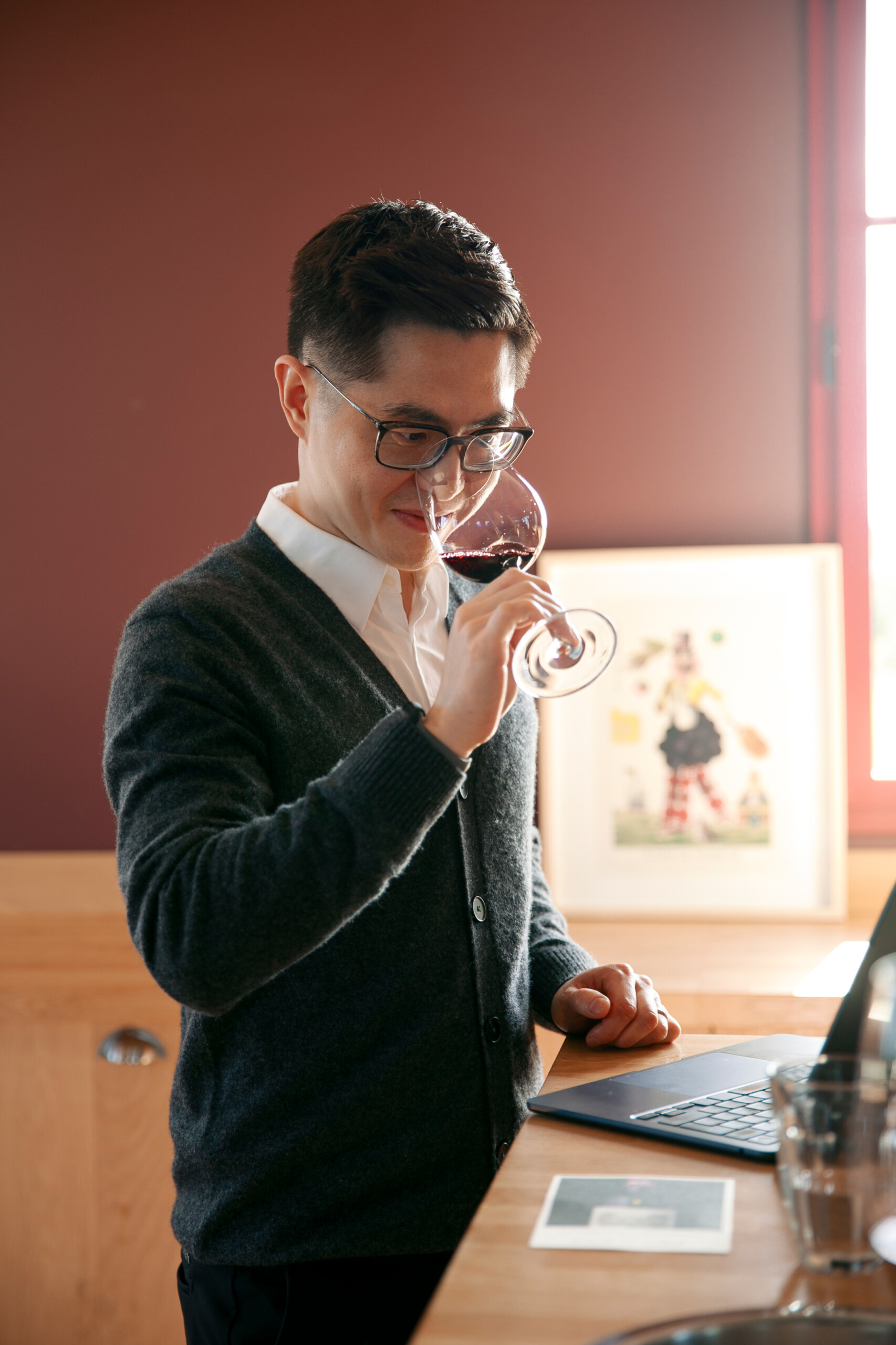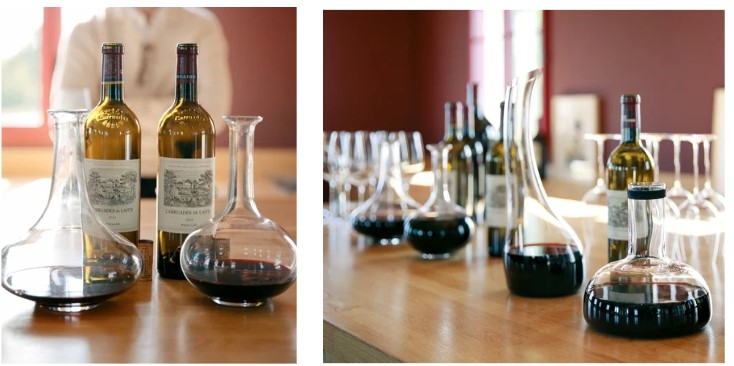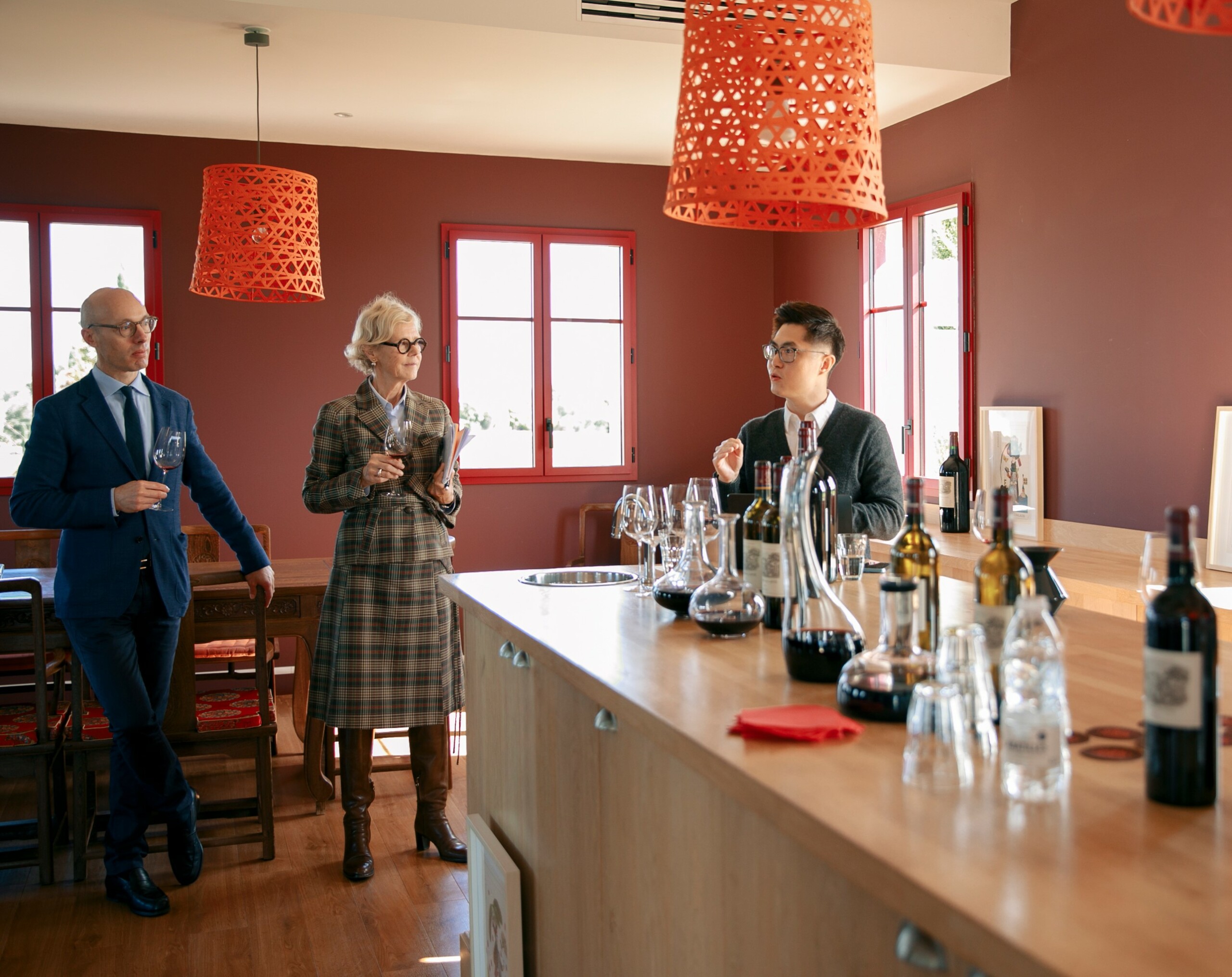🎧We are offering the Inside in an audio file
and
🎬Watch the tasting video
Alexandre Ma : Wine journalist and owner of AMA Sélection
Gerda Beziade: Journalist with Equipe Roland Coiffe & Associés
In this very first episode of our Regards Croisés series, we are honored to shine the spotlight on one of Bordeaux’s most emblematic estates: the prestigious Château Lafite Rothschild. In a captivating conversation, we’ll cross paths with Alexandre Ma, wine journalist and founder of AMA Sélection, and our sales team from Roland Coiffe & Associés. This dialogue takes place in a convivial atmosphere around an exceptional tasting of four carefully selected vintages:
Carruades de Lafite 2018 et 2010,
Château Lafite Rothschild 2016 et 2005
The aim of Regards Croisés is to offer an enriching exploration of terroirs, vintages and the soul of wines through the vision of experts and enthusiasts. This first episode perfectly illustrates the elegance and uniqueness of Lafite, a Premier Cru Classé that fascinates with its restraint, balance and ability to endure the decades.
Alexandre Ma
Gerda : Alexandre, what’s your general view of Château Lafite Rothschild?
Alexandre Ma : Of all the Premiers Crus Classés, Lafite always has one advantage in any vintage: it has a moderate alcohol content. That’s a great advantage in today’s climate change context.
G : Why do you find this advantageous? Are today’s consumers sensitive to alcohol levels in wine?
AM : When the terroir is too early, the grapes risk being affected by over-ripeness. These wines, as sometimes in the 2015 vintage, certain crus don’t hold up, or at least not on the long road. They can be kept for 10 years, but beyond that, they risk going in another direction. But Lafite, thanks to its exceptional terroir, achieves optimum ripeness with relatively modest alcohol levels. In a hot, sunny, very dry vintage like 2022 or 2020, the alcohol levels at Lafite were lower than those of other wines in that vintage. That’s my first general point about Lafite. My second point is that Lafite is never opulent.
G : Yes, I totally agree with you. It’s a pure expression of Cabernet Sauvignon which, at first glance, is rather restrained.
AM : On the surface, it’s never super-bright. If you taste Lafite too quickly and compare it with other wines from around the world that are strong, muscular and have a very high phenolic maturity, Lafite will of course be less opulent than those wines. That’s why I’m against doing blind tastings between Cabernet Sauvignons from warm climates and Lafite, because they’re incomparable. We can’t compare Sophie Marceau and Maryline Monroe. It’s hard to say who’s more beautiful! Everyone has their own preference.

G : Yes, I’ll always remember that the exceptional Paul Pontalier (General Manager of Château Margaux – who passed away in March 2016) said to me at the start of my career, “In Bordeaux, we produce wines that should be savored sitting around the table. We don’t produce competition wines”.
AM : Yes, I totally agree. Lafite is a wine that keeps a certain distance. If you’re patient, Lafite opens up over time.
G : Do you think that, thanks to this restraint and distance in its youth, Lafite can age remarkably well?
AM : Not only that. Thanks to this restraint, Château Lafite Rothschild makes us dream. Every time we open a bottle, we wonder what this wine has in store for us in the future… A great wine should never reveal too much immediately. It must always retain a potential, a richness, and a substance that reveals itself over time. It shouldn’t wake up all at once. Since 2018, Bordeaux wines have become more approachable in their youth. They are easier to understand than before, without losing their breed and identity. When I taste a wine today, I often say to myself that it’s good now and will certainly be good in the future. When you taste older vintages of Lafite, like the 2010 I tasted recently, you feel a “Grande Classe” style. It’s well-detailed, with very refined touches, and it has the controlled power of the Grands Pauillacs. Lafite has a natural charm. Nevertheless, in terms of fruit expression, Lafite 2010 is less expressive than more recent vintages.
G : We tasted 4 wines, including 2 vintages of Carruades de Lafite, 2018 and 2010, and 2 vintages of Lafite Rothschild, 2016 and 2005. It is often noted that there is a distinct style of Carruades de Lafite before and after 2014. Thanks to a strict selection process implemented by Technical Director Eric Kohler, production of Carruades de Lafite has fallen by over 50%. What do you think of Carruades de Lafite 2018, which is known as a sunny vintage?
AM : It’s fair to say that recent Carruades vintages are becoming increasingly “qualitatives”. The 2018 is a good example. It’s an “opulent” vintage overall. What I particularly like about the 2018 Carruades is that it expresses the characteristics of the vintage with great phenolic ripeness, expressive fruit, a little vigorous, but all the while retaining the same framework as Lafite. With its notes of graphite and pine cones, these are the elements that give us a foundation and confidence. We know that this wine is built to last. That’s very encouraging, even if it’s a style influenced by climate change.

G : Then we tasted Carruades’ 201 vintage, a vintage from before the changes that have been put in place. How did you find it?
AM : When I smelled and tasted the wine, I immediately said to myself “this is Lafite”. It has kept all the family’s identities. Compared to other Carruades vintages, the 2010 has more concentration and structure.
G : Yes, it also has more “earthy” aromas.
AM : Yes, we can mention some leather notes, but for me, this wine has no problem. These “earthy” aromas give me more freshness and density on the finish. When I smelled it, I immediately thought: “This wine is a reference. It perfectly embodies the style of the 2000s and demonstrates great cellaring capacity. This vintage is an excellent example. On the finish, there’s once again that pencil lead note that I often find in great wines. There’s a lot of it in the 2010, unlike 2018 when it was less present. This Carruades 2010 really has the allure of a Grand Vin.
G : Perhaps this means that the 2018 is more marked by the style of the vintage, whereas the 2010 has better preserved the Lafite style?
AM : Yes, absolutely.
G : Château Lafite Rothschild brought us two very fine vintages: 2005 and 2016. We started with the 2016 vintage. Everything was almost perfect during that year’s vegetation cycle. Pauillac received some welcome rain in mid-September, as the summer was dry and hot. The ripeness of the grapes was ideal at harvest time. What did you think of the vintage?
AM : I still remember the 2016 Primeur tasting very well, there were a lot of good wines. At first glance, I thought it wasn’t a typical Bordeaux vintage. On the palate, it didn’t have the Bordeaux style I usually recognize. It had much more tension than usual. If I had to compare it to a person again, the 2016 has the physique of a long-distance runner, rather than a boxer, it’s like a tall person with lanky muscles. The 2016 is bursting with energy, but sometimes I wonder when it will really enter the race and when it will fully express its identity. Maybe I’ll have to wait until my hair turns gray, because this Lafite 2016 is still very young. It’s fabulous! It’s one of the best Lafite vintages I’ve ever tasted. It might even surpass the 2010…

G : 2010 is perhaps a little more austere?
AM : For me, it’s more woody. The 2016 presents itself more naturally, while retaining the true identity of Lafite, with the presence of the vintage, which was warm.
G: The 2016 has perfect balance, but it’s still a bit in its “straitjacket”.
AM : Yes, it still has enormous potential. You could say that this 2016 will never age! I’d love to taste this wine again when my son (born in 2024) grows up.
G : After this great 2016, Château Lafite Rothschild spoiled us with a 2005. I was a little apprehensive, because at the time, I had bought quite a few magnums at the Primeurs, but I had found that this vintage had remained closed for a very long time. However, I was blown away by this Lafite 2005.
AM : On the palate, the wine is fantastic. It offers a hint of black ink that gradually melts away, bringing a creamy, unctuous texture, while retaining plenty of finesse, richness and complexity. It has a fabulous mouthfeel. As for the nose, compared to the 2016, the 2016 is like a diamond, illuminated by the sun, with many rays of light passing through the wine. But the 2005 is like entering a historic château. As soon as you step inside, you feel that authentic, plush atmosphere. This is Bordeaux class. The palate is better than the nose. The nose is dominated by notes of cold chimney, licorice and lots of spices.
G : Is the 2005 a little too “old-school” for you?
AM : I also really like this style. I simply compare it to the 2016. When I talk about Bordeaux from the 70s, 80s, 90s, 2000 and after 2018, each era has its own identity. Understanding the different identities of these periods is a bit like reading a book: you have to turn the pages to start a new chapter. When all the chapters have been brought together, a great story has been written. Bordeaux is that great book, and each vintage is a unique chapter in it.
G : Even if the 2005 had an impressive finish.
AM : Yes, it was quite “hairy” on the palate. It was like cashmere.
G : Is there anything else you’d like to add to this interview?
AM : If we’re talking about Bordeaux, and specifically Grands Crus, I think it’s essential to talk more about Bordeaux terroir, especially for the new generation. It’s too often forgotten. We can discuss blends and different types of soil, but above all we need to talk about terroir, which also includes the influence of man. In other words, when we talk about the Grands Crus of Bordeaux, we need to talk about the DNA of each wine. For example, if I want to enjoy an exciting wine with an expressive nose, I think of Palmer. If you’re looking for a sustained, dreamy wine, I think Branaire Ducru. If you’re looking for a powerful, energetic wine with great ageing potential, you might choose Montrose. If we talk to consumers in this way, Bordeaux will have a brighter future.
G : I have one last question. This summer, you did a long tour of China, your native country. How do you judge the current market in China?
AM : Due to the impact of the global economy, the Chinese market has recently performed rather lacklustrely. However, during my latest AMA Selection tours, I still saw some positive signs. Firstly, there are still genuine wine consumers, whose consumption is tending towards rationality rather than abandonment. Secondly, consumers’ desire to acquire knowledge about wine has clearly increased. So, while everyone talks about the weakness of the market, it’s actually a good time to strengthen the link with consumers. Because those who continue to enjoy wine today will become the driving force behind tomorrow’s wine market.

G : That’s a very good development!
AM : Yes, participants in my tastings have very often said to me: “This is a wine I really like, but where can I buy it?” I think that’s one of my missions as a wine critic. I pass on what I see and smell to the consumer. There’s a real interaction between us.
G : Would you say that education is essential? And that Bordeaux’s real strength lies in its ability to offer a wide variety of wines?
AM : A mature market is first and foremost characterized by a large number of wine lovers and loyal consumers. The most effective way to turn someone into a true wine lover is to arouse a genuine interest in wine and encourage them to spend time exploring it. But how do you capture the attention of consumers? In my opinion, wine education is essential. I’ve been working in wine education in China and France for almost ten years, and I’ve seen many people go from total ignorance to becoming loyal consumers of fine wines. The uniqueness of the Chinese market highlights the importance of education, and I think it’s an area that many châteaux and négociants should be focusing on in the coming years.

Gerda BEZIADE has an incredible passion for wine, and possesses a perfect knowledge of Bordeaux acquired within prestigious wine merchants for 25 years. Gerda joins Roland Coiffe & Associés in order to bring you, through “Inside La PLACE” more information about the estate we sell.

